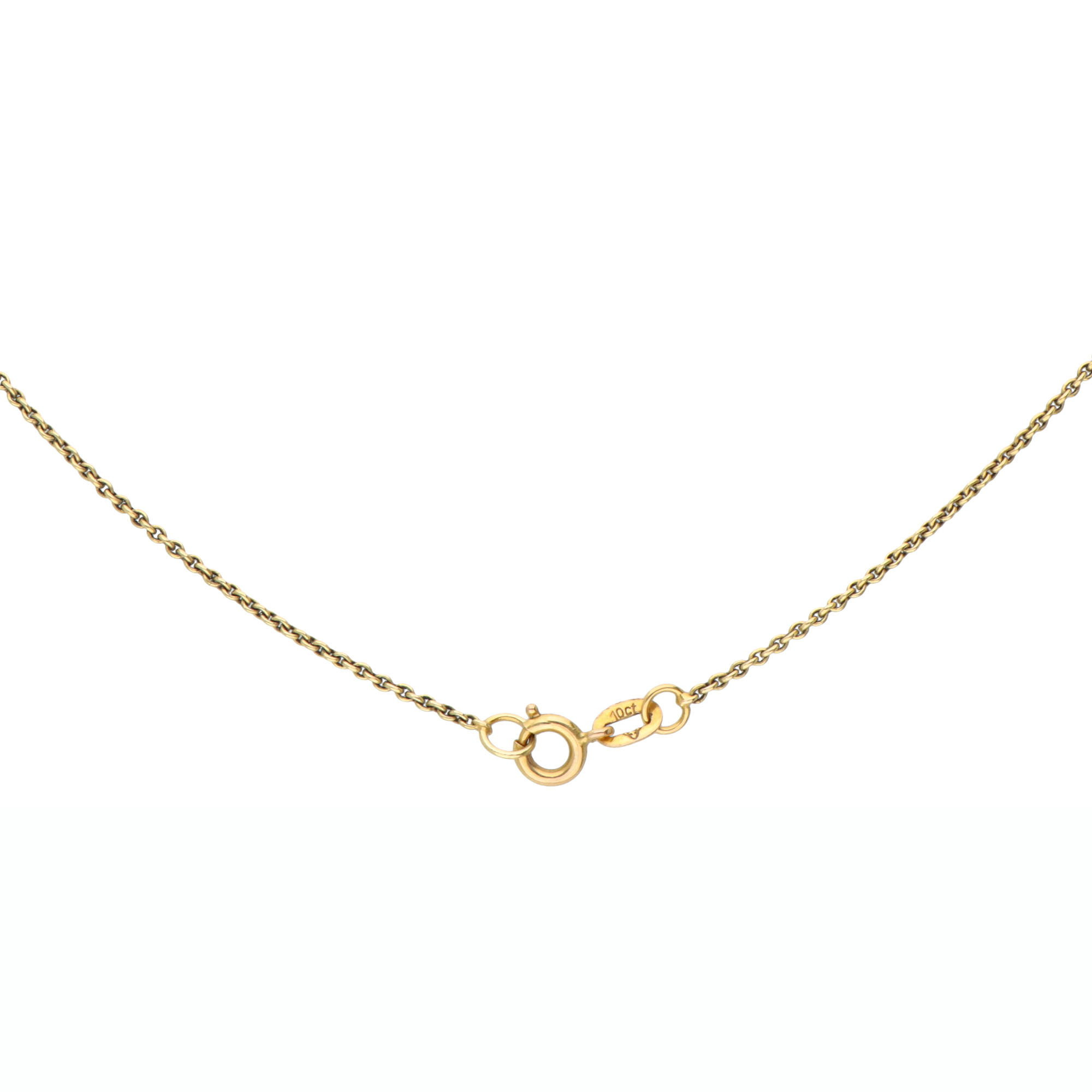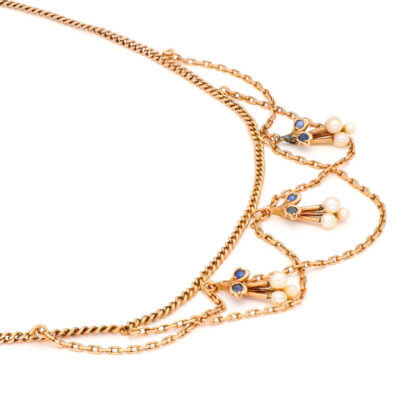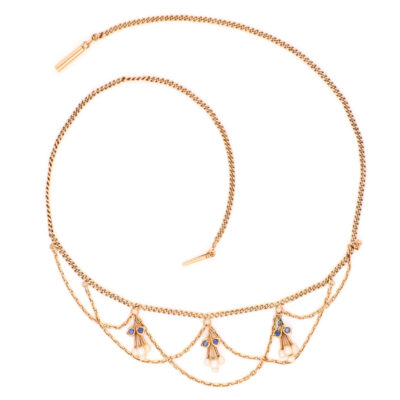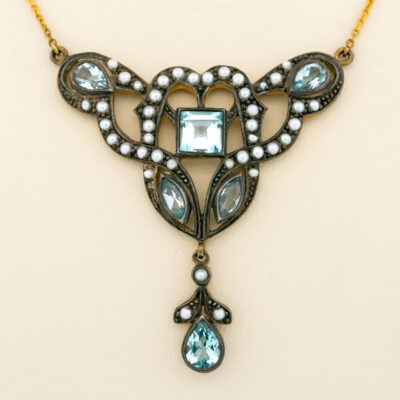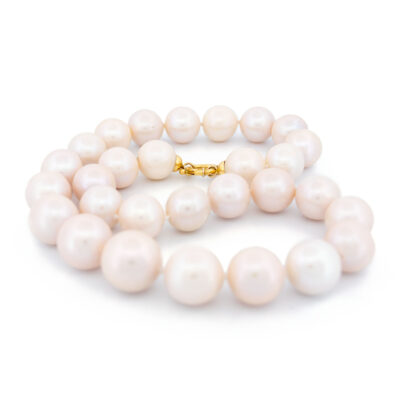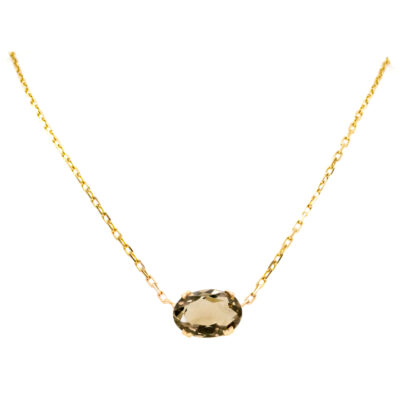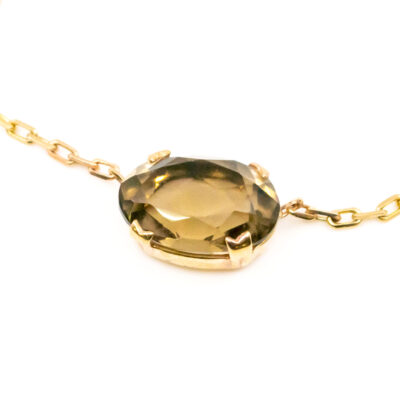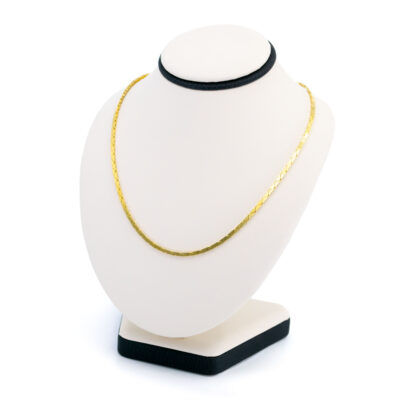A timeless treasure, this vintage-inspired necklace showcases deep red garnet clusters set in warm 10k yellow gold. Faceted garnets shimmer in prong settings along the delicate cable chain, leading to a floral-inspired pendant. At its heart, a bezel-set round garnet glows, encircled by smaller gemstones in a mesmerizing, multi-tiered design. Romantic and regal, this piece captures Victorian elegance with a modern twist.
Videos
Details: ±4.00ct Garnet, 10k Necklace.
Design Era: Mid 20th Century (1950-1970).
Dimensions: L: 42.5 cm.
Weight in grams: 4.4.
Condition: Good condition – used with some signs of wear.
Shipping and Pickup: This sophisticated piece ships from our store located in the center of Amsterdam, The Netherlands. We offer both registered shipping and local pickup at our store. In the case of local pickup, any applicable shipping costs will be refunded.
About Us: Add some sparkle to your style with Binenbaum.com. We offer a stunning selection of antique and vintage jewelry that you won’t find anywhere else. From timeless rings and dazzling necklaces to unique brooches, we have something for every taste and occasion. Visit our website today and treat yourself to a piece of history.
| Design Era | |
|---|---|
| Design & Historical Context | The 1950s were a time of great cultural and technological change, marked by the emergence of rock 'n' roll, the birth of the Beat Generation, the launch of Sputnik, and the beginning of the space race. These events, and the knowledge that the world was living in a nuclear age, contributed to the development of an aesthetic known as the Atomic Age, which was reflected in various aspects of design, including jewelry. |
| Key Materials | |
| Materials & Craftsmanship | Garnet: The Stone of Passion and Protection Garnet, renowned for its deep red hue, is a gemstone that symbolizes passion, energy, and protection. Though commonly associated with its rich red color, garnet actually comes in a variety of shades, including green, orange, and even rare blue, making it a versatile and intriguing gemstone. Garnet has a long history of use, dating back to ancient Egypt, where it was worn by pharaohs as a symbol of life and power. In Roman times, garnets were often set into signet rings used to stamp wax seals on important documents. The stone was also believed to offer protection to travelers and warriors, warding off harm and ensuring safe journeys. In jewelry, garnet’s durability, with a Mohs hardness of 6.5 to 7.5, and its striking color make it a popular choice for rings, necklaces, and earrings. Its ability to capture and reflect light with a warm, fiery glow adds a touch of drama and sophistication to any piece. Garnet is more than just a gemstone; it is a symbol of enduring passion and strength. Its vibrant energy and historical significance make it a timeless and powerful choice for jewelry that stands out and tells a story. 10k: The Practical and Stylish Choice with a Durable 10k Golden Hue 10k gold is a popular alloy used in jewelry, containing 41.7% pure gold and 58.3% other metals such as copper, silver, nickel, or zinc. This combination makes 10k gold a practical and affordable choice for those seeking the allure of gold while balancing cost and durability. Historical Context: Modern Jewelry Appeal: Color and Finishes: Yellow Gold: Offers a warm, subtle golden tone, although not as rich or intense as higher karat yellow gold. White Gold: Often rhodium-plated to enhance its white, silvery appearance, making it similar to platinum or sterling silver. Rose Gold: Features a pinkish hue achieved by adding copper, providing a romantic and stylish look. 10k gold is versatile and can be used in a wide range of jewelry designs. It pairs well with various gemstones and materials, allowing for a broad spectrum of styles from classic and elegant to modern and trendy. The metal’s affordability also allows for more experimentation with designs and settings. Metaphysical and Practical Considerations: 10k gold is more than just an economical choice; it represents a practical balance between cost and durability, offering a stylish and versatile option for everyday jewelry. Its affordability, combined with its golden hue and strength, makes it a valuable choice for those seeking the classic beauty of gold in a more accessible form. Whether chosen for its practicality or its elegant appearance, 10k gold provides a solid and attractive option for any jewelry collection. |
| Dimensions | L: 42.5 cm |
| Gender | |
| Weight (in grams) | 4.4 |
| Condition |
By following these tips, you can enjoy your precious jewelry for many years to come.
Related Products
-
Pearl Sapphire 14k Festoon Necklace 17440-9198
€ 2.395,00 VAT incl. (where applicable) -
Topaz Pearl 9k Silver Lavalier Necklace 10223-6515
€ 1.495,00 VAT incl. (where applicable) -
18k Pearl Classic Single-Strand Pearl Necklace 17518-9221
€ 1.695,00 VAT incl. (where applicable) -
Pearl 18k Single-Strand Pearl Necklace 17525-9228
€ 4.995,00 VAT incl. (where applicable) -
Diamond Platinum Festoon Necklace 11149-6268
€ 2.495,00 VAT incl. (where applicable) -
Diamond 18k Vintage Necklace 12789-7054
€ 3.695,00 VAT incl. (where applicable) -
Quartz 9k Solitaire Necklace 12666-6295
€ 995,00 VAT incl. (where applicable) -
14k Cobra Link Necklace 16720-8956
€ 2.495,00 VAT incl. (where applicable)
- Home
- Collection
- Fine Jewelry
- Silver Jewelry
- Silverware
- Boxes
- Candlesticks
- Salt and pepper shakers
- Miniatures
- Salt cellars
- Spoon Set
- Condiments
- Frames
- Napkin Ring
- Spoon
- Oddities
- Cups
- Vases
- Cutlery
- Serving Spoon And Cake Server
- Candlesticks
- Baskets
- Hanukkiah
- Spice Tower
- Yad
- Tea Set
- Sugar Castor
- Napkin Rings
- Wine Bottle Coaster
- Wine Stopper
- Tea Pot
- Jugs
- Rattles
- Hip Flask
- Miscellaneous
- Rings 💍
- About
- Contact



